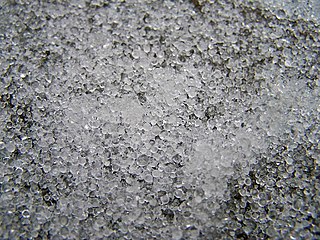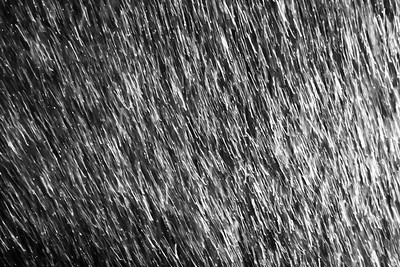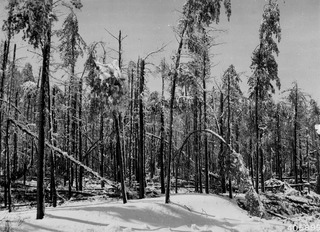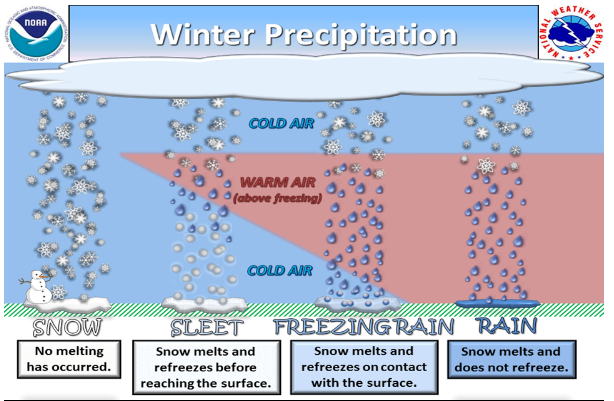Sleet (5e Hazard)
Sleet[edit]
Sleet is a form of winter precipitation composed of round ice pellets no larger than a pea. Sleet is caused by a temperature inversion--a layer of warm air sandwiched between two layers of cold air--that causes snow to melt and then refreeze as it descends. Because a temperature inversion is required, sleet doesn't typically fall in regions that are uniformly cold in the winter (such as the Arctic or the middle of Siberia) but rather in coastal areas in moderate climates, where a warm layer of air over the (relatively warm) ocean can intrude over the colder land during winter (for example, the U.K., Denmark, North Carolina and Virginia in the U.S.). Sleet pellets typically bounce as they hit the ground. Sleet can quickly coat the surface of the ground with Glaze, making movement hazardous. Glaze is a smooth coating of ice pellets on the ground and on objects such as trees, roads and rooftops.
OMEN/SIGN: [In winter] Although temperatures are freezing today, a storm approaches after several days of alternating freezing and mild temperatures. [Druids and Rangers may make a DC 8 Intelligence (Nature) check to recognize that these conditions are favorable for Sleet.]
EFFECTS: The effects of sleet are a combination of the effects of rain, snow and ice. Glaze (fallen Sleet) hinders movement much more than Difficult Terrain.
- Unlike hail, falling sleet pellets are too small to cause direct damage.
- Sleet falls for 1d20 minutes.
- Sleet reduces visibility ranges by half (including Darkvision) and Lightly Obscures the area when falling, resulting in Disadvantage (or, alternatively, –4 penalty) on ranged weapon attacks, Spot checks, Search checks, Listen Checks, and Wisdom (Perception) or Passive Perception checks relying on sight or hearing.
- Unprotected flames (torches, campfires, etc.) have a 50% chance of being extinguished, but, unlike rain, protected flames (such as those in lanterns) are unaffected by Sleet.
- Creatures attempting to *move horizontally* on Glaze *while not in engaged in combat or other strenuous activity* must make a DC 14 Dex save or fall prone. Upon a successful save, a creature *not in engaged in combat or other strenuous activity* may continue moving horizontally through Glaze as through Difficult Terrain (moving 1 foot in Difficult Terrain costs 2 feet of speed, so you can cover only half the normal distance per time period).
- Creatures attempting to *remain standing or move horizontally* on Glaze *while engaged in combat or other strenuous activity* must make a DC 16 Dex save *each round* or fall prone.
- Creatures attempting to *stand up* (from a prone position) on Glaze must make a DC 12 Dex check or remain prone.
- Creatures attempting to *move up/down a slope* on Glaze under any circumstances must pass a DC 18 Dex save *each round* or fall prone.
- Any unmoving object outdoors during Sleet is covered with Glaze, becoming very slippery, and requiring a DC 10 Dex check to pick up.
- If a creature is attempting to concentrate while in falling Sleet, the creature must make a successful DC 8 Con saving throw or lose concentration.
OPTIONAL EFFECTS:
- In forest, the weight of Glaze has a 50% chance of causing tree limbs to break and fall, causing 1d6 damage to creatures below.
- In structures, the weight of Glaze has a 25% chance of causing the roof to cave in, causing 1d8 damage to creatures inside (only the top story within a multi-story building).
- Any creature perched in a tree, on top of a wall, on battlements, etc., must make a DC 16 Dex save or fall, suffering typical falling damage.
DM TIPS: During winter in temperate climates or coastal regions, replace one item in your outdoor/wilderness Random Encounters table or Weather table with Sleet. Sleet makes it almost impossible for creatures to move up or down slopes, so attacking foes on a hill is much more difficult. Sleet makes outdoor combat *much* more exciting!
NOTE 1: Hail is different from Sleet. Hail consists of ice pellets, but hailstones can be much larger than sleet and form under different weather conditions. Hailstones are formed during thunderstorms in the spring and summer when updrafts generated by thunderstorms quickly lift water droplets to high altitude, where they freeze at very low temperatures, and then fall back to the ground.) Hailstones are large enough to cause damage directly when they fall.
NOTE 2: Freezing Rain is different from Sleet. Freezing Rain occurs when snowflakes descend into a warmer layer of air and melt completely without refreezing before reaching the ground. Upon contact with the ground or objects that are at or below freezing, a layer of Glaze is typically formed. Glaze is a smooth coating of ice on the ground and on objects such as trees, roads and rooftops. An accumulation of Glaze is heavy and can cause tree limbs and even roofs to break. A period of freezing rain lasting several hours or more is called an Ice Storm.
SOURCES: https://en.wikipedia.org/wiki/Sleet https://education.nationalgeographic.org/resource/sleet/ https://www.weather.gov/iwx/sleetvsfreezingrain https://www.dandwiki.com/wiki/SRD:Weather#Snow https://www.dandwiki.com/wiki/SRD:Weather#HeavySnow https://www.dandwiki.com/wiki/SRD:Weather#Sleet https://www.dandwiki.com/wiki/SRD:Weather#Hail https://www.dandwiki.com/wiki/5e_SRD:Sleet_Storm https://www.dandwiki.com/wiki/SRD:Sleet_Storm https://www.dandwiki.com/wiki/Sleeted_Ground_(3.5e_Incantation)
Back to Main Page → 5e Homebrew → Hazards




